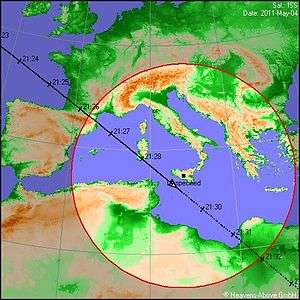List of satellite pass predictors

The following is a list of tools on a variety of platforms that may be used to predict the pass of an orbiting artificial satellite over a given point on Earth. They are used to generate a list of dates, times and directions when and where objects such as the International Space Station, Genesis, or Tiangong 1 space stations will be visible to ground observers, as well as many man-made objects that can be seen with the unaided eye including the Hubble Space Telescope.
Web based
- Heavens-Above, called "the most popular website for tracking satellites" by Sky and Telescope magazine and referenced by NASA websites.[1][2] Linked from both NASA and ESA websites as a reference for locating satellites and spacecraft.[3] Includes predictions for the ISS, space shuttle and other bright satellites, planets, minor planets, and comets.
- JPass, a java based web application. Offline since April 2010, replaced by NASA Skywatch web application.[4]
- NASA Skywatch, Java based web application. Predicts visible passes for spacecraft, satellites and space debris.[5]
- AMSAT Online Satellite Pass Predictions.
- n2yo provides real time tracking and pass predictions with orbital paths and footprints overlaid on Google Maps.[6]
- CalSky a service offered by Arnold Barmettler for astronomers to plan their observing sessions. Features a calendar (and/or email notifications) generated for your location including information on aurora, comets, tides, solar and lunar eclipses, planets, bright satellite passes (ISS, HST, etc.), occultations, transits, Iridium flares, and decaying satellites that may be visible.[7]
Mobile devices
iOS
This section includes applications for the iPhone, iPad and iPod touch. Apps generally use coordinates provided by the device's built in GPS. Some require an active internet connection others update periodically
- GoSatWatch from GoSoftWorks, supports multiple viewing sites (home, vacation spot, etc.), no internet connection required (one data is loaded and periodically updated). View satellite position on world map or a simple polar chart showing the path the satellite will take across your sky.[8]
- ISS Visibility, interface to Heavens-Above, predictions up to 30 days out, ground tracks, star chart with path shown.[9]
Android
- Satellite AR, by Analytical Graphics augmented reality view of the sky for currently visible satellites only. Includes modes for ISS and bright objects as well as modes which include the thousands of all known satellites.[10]
Cross-Platform
- SpyMeSat,[11] by Orbit Logic, a mobile app for iOS and Android, computes pass predictions for any selected location for available commercial and unclassified government high resolution imaging satellites and provides real-time notifications and dynamic real-time imaging resolution and satellite position information and maps during predicted passes. SpyMeSat also includes the ability to download recent high resolution satellite images for the user-selected location, or task selected imaging satellites to take a new image.[12][13]
Software libraries
- Astro::satpass Perl library by Tom Wyant, calculates star, sun, and moon positions as well as satellite pass predictions. Interfaces with Celestrak or Space Track.[14]
- OreKit Java library for low level space dynamics library.[15]
Raw orbital data
All websites and applications base their predictions on formula using two-line element sets which describe the satellites and their orbits.
- Celestrak provided by Dr. T.S. Kelso, includes visible objects, openly available [16]
- SpaceTrack maintained by the United States Strategic Command provides orbital information on unclassified satellites requires an account but is available for educational and hobbyist use as well as military, government and spacecraft and payload owners.[17][18]
- JPL Horizons On-Line Ephemeris System, maintained by the Solar System Dynamics Group at the Jet Propulsion Laboratory, provides ephemeris for asteroids, comets, planets, moons, solar system planets, the Sun, and some spacecraft.[19]
- Satellite Calculations
References
- ↑ Shuttle Sightings - NASA Science
- ↑ Take a "Sat-seeing" Tour - What’s Up Tonight? - SkyandTelescope.com
- ↑ ESA - Human Spaceflight and Exploration - International Space Station - See the ISS from your home town
- ↑ Internet Archive Wayback Machine
- ↑ Double Spaceship Sighting Alert — and Last Chance to See Endeavour in Orbit
- ↑ New scientist. 190 (2551): 29. May 13, 2006. Missing or empty
|title=(help) - ↑ The Zimbabwe Science News. 33: 24. 1999. Missing or empty
|title=(help) - ↑ The space station in the palm of your hand | The Space Shot - CNET News
- ↑ PAUL, SALAZAR. "Review of iPhone Astronomy Apps: ISS Visibility and Iridium Flares". KFOG.
- ↑ Satellite AR: Satellite tracking with augmented reality on Android
- ↑ http://www.spymesat.com/
- ↑ SpyMeSat Mobile App Now Offers High Resolution Satellite Imagery
- ↑ SpyMeSatGov: satellite imagery mobile app for government
- ↑ Tom Wyant / Astro-satpass - metacpan.org
- ↑ "CS launches the 1rst [sic] free operational Space Flight Dynamics". CS Communication & Systèmes.
- ↑ Welcome to Center for Space Standards & Innovation (CSSI)
- ↑ Space-Track - New Account
- ↑ Palgen, Trevor (2010). Blank spots on the map : the dark geography of the Pentagon's secret world (Updated ed.). New York: New American Library. ISBN 0-451-22916-9.
- ↑ Webb, Stephen (1999). Measuring the universe : the cosmological distance ladder ([Repr.] ed.). London: Springer. ISBN 1-85233-106-2.